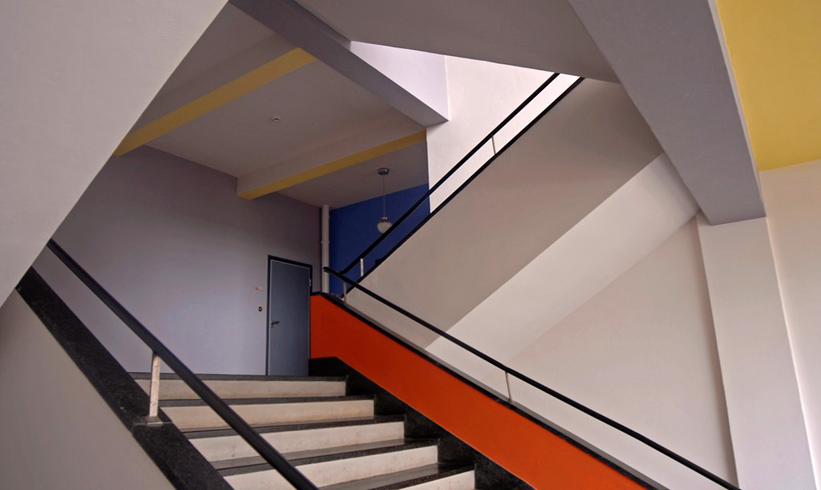From Our House to Bauhaus: Crafting the Creative Curriculum
5/12/2019
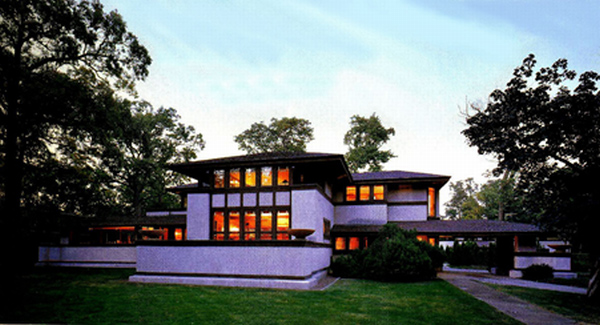
Tom Wolfe, in his book From Bauhaus to Our House, had it backwards: The Bauhaus, rather than being alien to the United States as Wolfe suggests, was originally home grown. The Bauhaus, established by architect Walter Gropius to promote a powerful fusion of art, technology, and craft, has renewed relevance now, when people are looking at ways in which education can stimulate creativity and innovation through learning that is more "hands on." The Bauhaus (German for "build house") was a "makerspace" par excellence. Far more often, architects shape the spaces in which learning occurs rather than the learning curriculum itself. Yet architects, since they straddle the fields of art and technology, have unique insight into the kinds of creative curricula now sought for STEM, and even more especially STEAM education. An overview of the Bauhaus highlights this.
Wolfe traced the origins of the Bauhaus to Europe following World War I. He saw the Bauhaus and its principles as alien, even hostile, to the United States. Yet had he traced it back a little further, he would have found its truer origins in Chicago, where at Hull House in 1901 Frank Lloyd Wright gave his lecture, "The Art and Craft of the Machine." In it, Wright suggested creating a machine-oriented crafts society, like a Guild, that collaborates with manufacturers. It would take excursions to factories to learn industrial processes firsthand, with an eye towards improving the work produced by applying improved design. Wright proposed that rather than fleeing from machine technology towards an antiquarian Arts and Crafts approach, architects should instead embrace and exploit new technologies, and reconcile their aesthetic with them. He outlined a sort of trade school in which industry and institution unite in a new synthesis of machine aesthetic, technology, crafts, and architecture: the "art and craft of the machine."
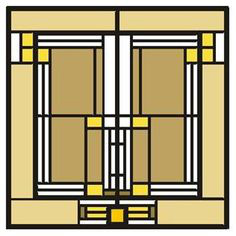
Wright suggested that simplicity of expression in harmony with machine technology arises naturally when that technology is properly understood: “Now let us learn from the Machine. It teaches us that the beauty of wood lies first in its qualities as wood; no treatment that did not bring out these qualities all the time could be plastic, and therefore not appropriate-so not beautiful, the machine teaches us, if we have left it to the machine that certain simple forms and handling are suitable to bring out the beauty of wood and certain forms are not; that all woodcarving is apt to be a forcing of the material, an insult to its finer possibilities as a material having in itself intrinsically artistic properties, of which its beautiful markings is one, its texture another, its color a third.” This new Guild, Wright envisioned, would learn how to handle wood, steel, iron, cement, and other materials by learning from machine technology, and through this their designs will be purified. “(T)he Machine is a marvelous simplifier; the emancipator of the creative mind, and in time the regenerator of the creative conscience.”
Wright summarized his vision by saying that “not one educational institution in America has as yet attempted to forge the connecting link between Science and Art by training the artist to his actual tools, or, by a process of nature-study that develops in him the power of independent thought, fitting him to use them properly.”
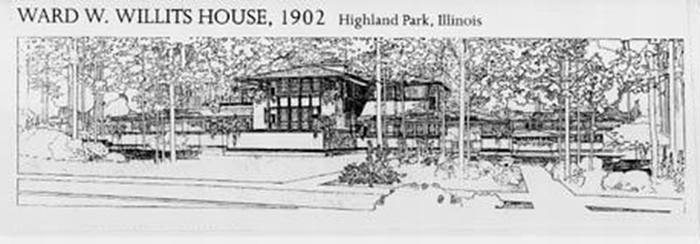
Yet it remained for Gropius to implement this vision, two decades later in Germany. Gropius’s architecture had been influenced by Wright’s architecture, which he saw in the Wasmuth portfolio, published in Germany in 1910. His Bauhaus curriculum echoed Wright’s vision as well. Gropius summarized the situation facing postwar Germany in terms that echo Wright’s own view of nineteenth century Chicago in his Hull House lecture: “When, in the last century, the machine-made products seemed to sweep the world, leaving the craftsmen and artists in a bad plight, a natural reaction gradually set in against the abandonment of form and the submersion of quality. Ruskin and Morris were the first to set their faces against the tide, but their opposition against the machine could not stem the waters. It was only much later that the perplexed mind of those interested in the development of form realized that art and production can be reunited only by accepting the machine and subjugating it to the mind. ‘The Arts and Crafts’ schools for ‘applied art’ arose mainly in Germany, but most of them met the demand only halfway, as their training was too superficial and technically amateurish to bring about a real advance. The manufactories still continued to turn out masses of ill-shaped goods while the artists struggled in vain to supply platonic designs. The trouble was that neither of them succeeded in penetrating far enough into the realm of the other to accomplish an effective fusion of both their endeavors.” (Walter Gropius, The Scope of Total Architecture, P 9)
Wright, though he envisioned it, did not have the focus on education to put it into practice. Gropius, a more committed educator, instead advanced the curriculum that trained generations of artists, designers, and architects. Gropius founded the Bauhaus in Weimar in 1919 as a school that would bring together fine arts and traditional crafts. In its early years, its teaching emphasized expressionism and individual craftsmanship, somewhat along the lines of a traditional Guild.
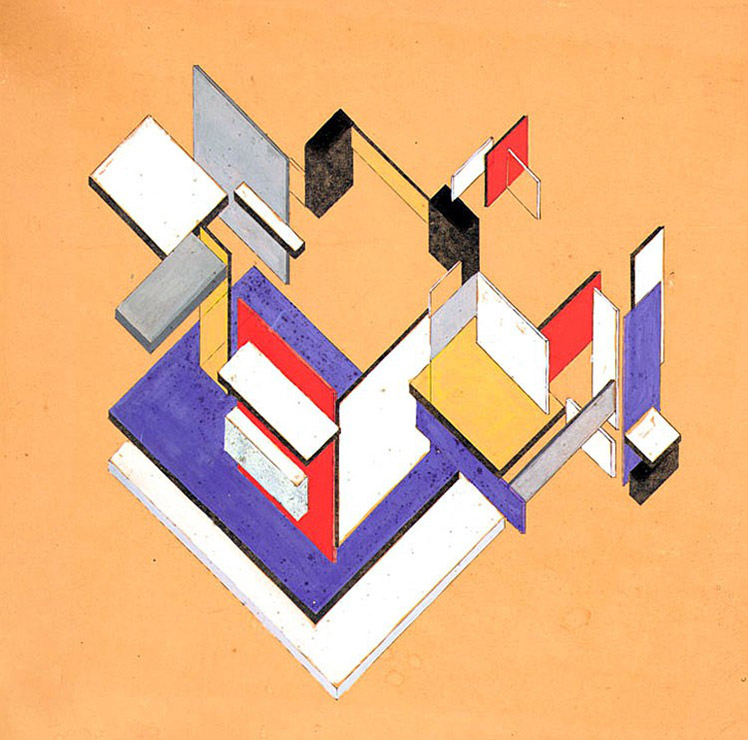
Holland, which had sat out WWI, arrived at an advanced modern aesthetic ahead of Germany. The Dutch painter and architect Theo Van Doesburg’s De Stijl aesthetic was inspired in part from the linear pattern of Wright’s Willits House and the influence of the Wasmuth portfolio. His De Stijl aesthetic has more the clarity we associate today with the Bauhaus than did the early expressionist projects being produced there. In it, the linear and planar clarity of separate parts is combined with shifting spatial relationships that result in a machined freedom.
Van Doesburg came to Weimar in 1921 hoping to secure a teaching post at the Bauhaus and spread his ideas of De Stijl. But Gropius found him overbearing and refused him a position. So instead he set up across the street from the Bauhaus, where he held soirées that were attended by Bauhaus teachers including Lyonel Feininger, Paul Klee, and Wassily Kandinsky, as well as his own private De Stijl courses that were attended by a number of Bauhaus students. In these, he criticized the Bauhaus curriculum and argued for greater objectivity, impersonality, machine production, and technology. This spurred Gropius to change his Bauhaus pedagogy, and helped Gropius resolve his own desire for spatial movement and a closed, hard, machined aesthetic, such as he had pursued in his own architecture.
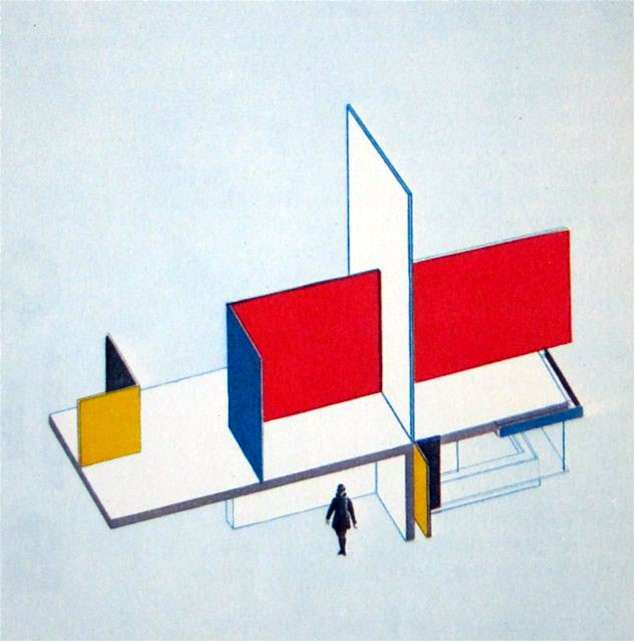
By 1922, two decades after Wright’s lecture, Gropius changed the focus of the Bauhaus from more expressionistic craft to the rigorous understanding of industrial methods of production under a “design master.” Its faculty mastered the intellectual as well as technical knowledge needed to produce artistically designed, economical goods. The Bauhaus workshops, which included metal, weaving, pottery, furniture, typology, wall painting, and (after 1927) architecture, included manual as well as formal training, and were the birthplaces of a new approach to industrial design. When the Bauhaus moved to Dessau, it also gave birth to the highly influential Bauhaus buildings themselves. “The Bauhaus,” Gropius wrote, “aimed at the training of people possessing artistic talents as designers in industry and handicrafts, as sculptors, painters and architects.” He felt that artistic ability was natural and common, but that “innate artistic ability can only be intensified by influencing the whole being, by the example of the design master and his work.”
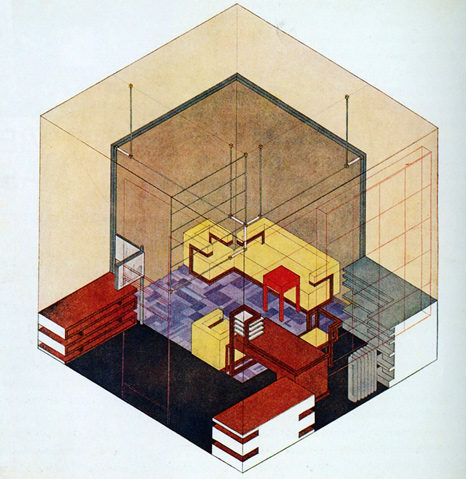
New to the Bauhaus was its effort to unite art and industry, to integrate artist and craftsman. The unity of arts had also been central to the late 19th-century Arts and Crafts movement, and the ideals of William Morris influenced Gropius's curriculum for the school. Yet at the Bauhaus, the focus on craft continually gave way to the focus on deriving form from production methods, material constraints, and programmatic necessities. It steadily abandoned the Arts and Crafts romance of individualized craftsmanship to embrace 20th-century machine culture. Its aesthetic, in harmony with machine technology and mass production, demanded design clarity and reduction to essentials. Breuer’s tubular steel chairs exemplify this approach to creative design solutions aligned with production technology. “To an ever greater degree,” as Walter Benjamin wrote, “the work of art reproduced becomes the work of art designed for reproducibility.”
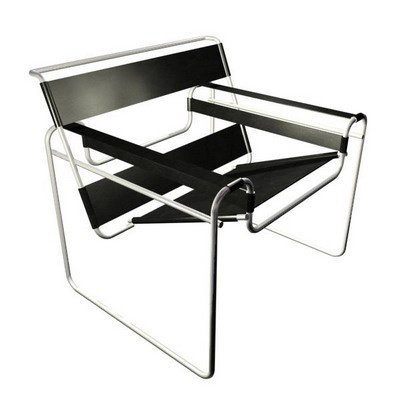
Full Circle
When the German Bauhaus closed in 1933, many of its design masters moved to the United States.
Josef and Anni Albers emigrated to America in 1933, where they taught at Black Mountain College in North Carolina and developed a foundation course based on the original ideas of the Bauhaus. Josef later taught at Yale. Moholy-Nagy went to Chicago, where in 1937 he founded his own art institution, the "New Bauhaus", which like its successor, the Chicago Institute of Design, adopted and expanded Gropius's original curriculum. It too aimed at the education of the widely oriented universal designer. Mies van der Rohe also moved to Chicago where he designed the campus and taught at the Illinois Institute of Technology. Marcel Breuer and Walter Gropius taught at Harvard. And the methods of the German Bauhaus were also adopted in modified form by other American schools by professors with no original connection to the Bauhaus. The Bauhaus became responsible for the gradual reduction of the previously unchallenged predominance of the Beaux-Arts tradition in the United States. More than an institution, the Bauhaus was an idea, and this is what gave it tremendous power.
Architects most often are responsible for shaping the spaces where learning happens, rather than in shaping the learning curriculum itself. Yet since their work forces them to straddle the fields of science, technology, engineering, art, and math, they have insight into the training these fields require. So when, as here, architects do get involved in shaping curricula, it can have great effect. The Bauhaus was a brilliant response to the need for a new type of design education in the 20th century. Since it was more an idea than just an institution, it had outsize influence. It raises the question of what is the appropriate type of design education in the 21st century, what form might it take, and what role might architects have in it?
